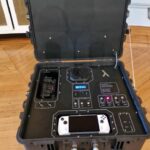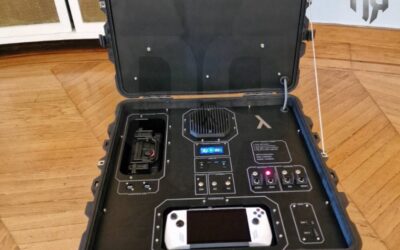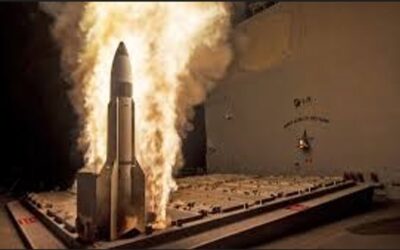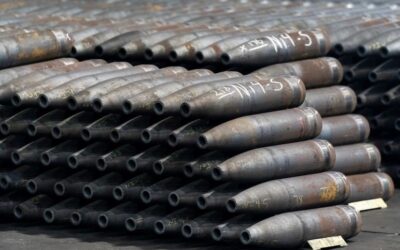The recent presentation of the start-up company Lambda Automata at the “Investing in Deep Tech: Dual-Use Technologies” conference…
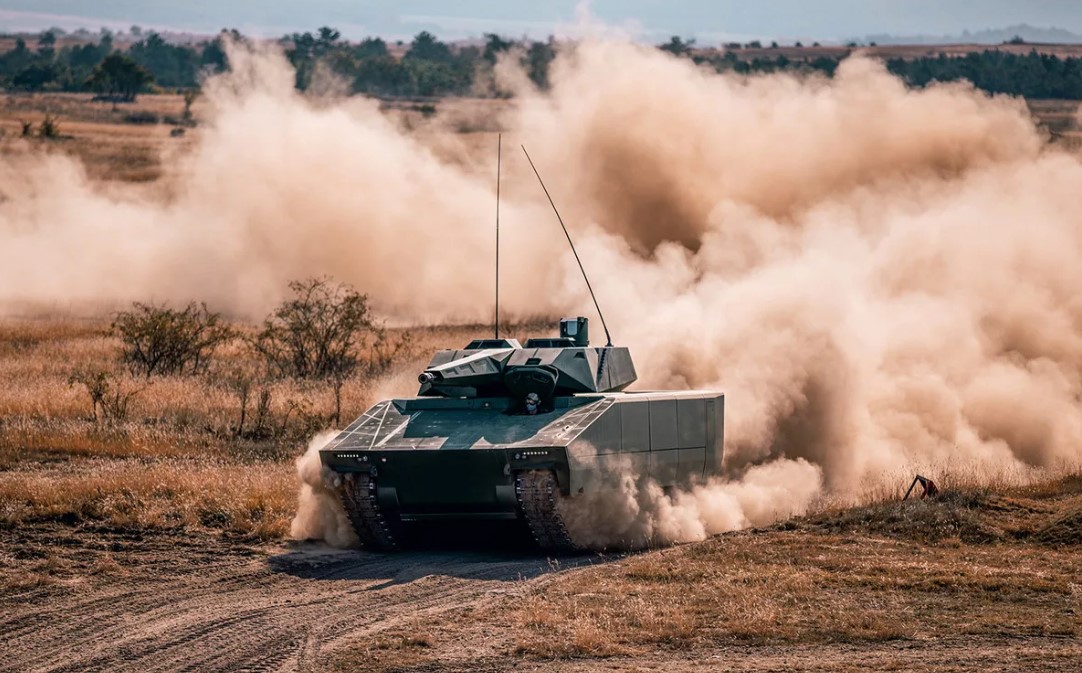
On October 15, 2022, Rheinmetall handed over the first of a total of 209 Lynx Infantry Fighting Vehicles (IFVs) to the Hungarian Defence Forces (HDF).
The handover took place during an oath ceremony of new military service volunteers of the Hungarian Defence Forces at the Petöfi Sándor Barracks in Budapest.
Hungary is the first NATO and EU member nation to receive the IFV in question, which will become the backbone of Hungary’s mechanized infantry forces within the framework of the country’s multi-year armament program (Zrínyi 2026).

#Rheinmetall hands over first Lynx infantry fighting vehicle to #NATO member Hungary🇭🇺- just two years after order was placed. #Lynx will become the backbone of Hungary's mechanised infantry forces. #army #military https://t.co/YLf0D2xMGv pic.twitter.com/v9uZ8edeVZ
— Rheinmetall (@RheinmetallAG) October 18, 2022
The delivery comes just 2 years after the signing of the agreement in August 2020 when the Hungarian Ministry of Defence awarded Rheinmetall an order for the supply of armored infantry fighting vehicles and related products and services with a total value of more than 2 billion euros. The total delivery package includes over 218 Lynx (209 KF 41 IFV version), ammunition and logistical support, 9 modern Buffalo armored recovery vehicles as well as 9 armored vehicle launched bridges (AVLB), and 16 trucks.
The Lynx KF41 for the HDF is delivered in seven variants including infantry fighting vehicles (IFVs), command posts, reconnaissance, joint fire observers, mortar carriers, field ambulance vehicles, and driver training vehicles. The contract also includes additional Rheinmetall products and services such as simulators, training, and instruction, plus an initial supply of spare parts as well as maintenance support.
The first batch of 46 Lynx vehicles will be delivered from Rheinmetall’s plants in Germany. By the end of next year, Rheinmetall will start to deliver the remaining vehicles from their Hungarian plant (under construction) – and specifically in Zalaegerszeg as part of the ZALAZone industrial complex.
To this end, the Hungarian government and Rheinmetall agreed in August 2020 to establish a joint venture responsible for creating a Lynx production facility in Hungary. Such a model is likely to be followed by Greece, since the German giant already cooperates with the Greek company EODH, which is a key partner of large companies of the defence industry in the field of complex multilayered armor for main battle tanks and combat vehicles.
Also read: EODH SA | From Lakkoma, Halkidiki to the core of the European Defence Ecosystem
HDF KF41 Lynx specifications:
- Maximum weight: 50 tons
- Maximum speed: 70 km/h
- Operational range: 500+ km
- Length: 8.49 meters
- Width: 3.73 meters
- Crew: 3+8 hoplites with a full load
- Engine: Liebherr D9612 1463 hp
- Modular armor combined with StrikeShield Active Protection System and ROSY rapid obscuring system
- 20 kW electrical power with lithium batteries
- Capability to transport UAVs and loitering munition (e.g. HERO by UVision)
Armament
The Lynx IFVs for the HDF are equipped with a Lance 2.0 turret which carries a 30mm MK 30-2/ABM 30 gun, a remote-controlled Main Sensor Slaved Armament (MSSA) weapon station with SEOSS-2 (Stabilized Electro-Optical Sensor System) and a 12.7 mm machine gun with hunter-killer capability. The 12.7mm machine gun can engage high angle targets including UAVs. The Hungarian Lynx also comes with StrikeShield active protection system and ROSY rapid obscuring system.

#Lynx KF41 🇭🇺 beast mode on
➡️ All round #StrikeShield #aps
➡️#ROSY Rapid Obscuring System
➡️ 30mm 30-2/ABM cannon mounted on #Lance 2.0 turret with coaxial RMG 7,62 and an additional 0,50 on #SEOSS #MSSA #RCWS suitable for the engagement of targets at high elevation i.e #UAVs https://t.co/ihu2MuY2qB— DEFENCE ReDEFiNED (@Def_Redefined) October 18, 2022
Rheinmetall StrikeShield APS system is a hybrid solution that combines active and passive protection with a modular design, while it features minimal collateral damage to the vehicle area.

1/2 #lynx Το σύστημα ενεργής αυτοπροστασίας #strikeshield #aps της @RheinmetallAG στο Lynx #KF41 των Ουγγρικών Ενόπλων Δυνάμεων.
➡️ Υβριδική λύση που συνδυάζει ενεργητική και παθητική προστασία με αρθρωτό σχεδιασμό
➡️ Ελάχιστες παράπλευρες ζημιές στην περιοχή του οχήματος👇 pic.twitter.com/6AX7Yc3Hry— DEFENCE ReDEFiNED (@Def_Redefined) October 17, 2022
Additionally, it features a low electromagnetic footprint compared to other APS systems. Below, you can check out the chart which shows a “chaotic” difference, according to Rheinmetall.
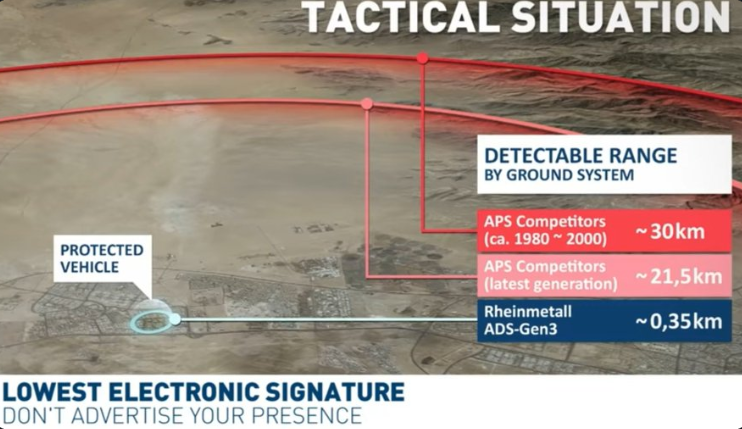
2/2
➡️ Πολύ σημαντικό το χαμηλό ηλεκτρομαγνητικό του ίχνος εν συγκρίση με λοιπά συστήματα #aps. Δείτε το γράφημα το οποίο παρουσιάζει "χαοτική" διαφορά σύμφωνα με την #Rheinmetall
➡️ Απαραίτητα το #aps & η παθητική θωράκιση για επιβιωσημότητα στο σύνθετο επιχειρησιακό περιβάλλον pic.twitter.com/KEsw9IJcdJ— DEFENCE ReDEFiNED (@Def_Redefined) October 17, 2022
APS and passive armor are essential for survivability in a complex operational environment. As such, the Lynx combines the modularity of passive and active protection systems providing multi-layered protection capabilities against prevalent battlefield threats.
Lynx protects the crew members from the full spectrum of battlefield threats, including explosions, improvised explosive devices (IEDs), direct and indirect fire, cluster munitions, and anti-tank guided missiles as well as CBRN.
The ROSY rapid obscuring system, unlike conventional rapid obscuring systems, is capable of creating a dynamic smoke screen both instantaneous and wide-ranging multispectral line-of-sight (LOS) disruption.
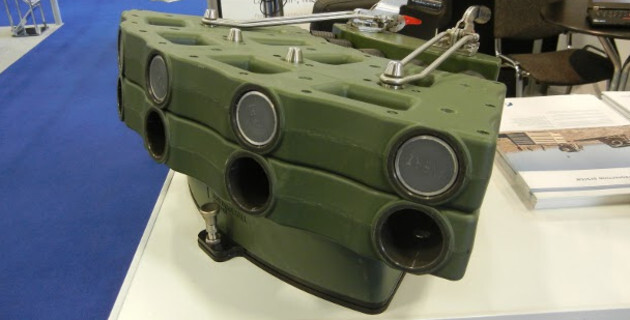
Due to its built-in infrared (IR) jamming and decoy capabilities, the ROSY according to the company, is capable of effectively countering all guided missile systems that use camera targeting (TV), electro-optical sensors (EO), IR, and IIR targeting systems, via laser beam and Semi-Automatic Command to Line of Sight (SACLOS) guidance. The system uses 40mm caliber munition and the smoke screen creation time even for moving vehicles does not exceed 2 seconds.
Also read: Lynx 120 | The new version of the Rheinmetall armored vehicle with a smoothbore gun
The aforementioned protection systems of the Hungarian Lynx will work in cooperation with the tactical situational awareness system built into the vehicle, which will process all the data from the sensors and provide a unified battle picture. The system also includes Rheinmetall’s SCM 60 cameras equipped with a day and infrared camera, which will provide full 360-degree coverage around the Lynx.

Rheinmetall’s Situational Awareness System
Protection is enhanced by the also integrated laser warning receiver (LWR), which warns of an attack by SACLOS anti-tank missile systems launched against the vehicle.
Further, the Lance turret 2.0 operates enhanced sensor systems to fully exploit the capabilities of the integrated 30mm firing next-generation programmable kinetic energy time fused (KETF) ammunition and the modern anti-tank missile system offering an engagement capability for symmetric and asymmetric threats.
Lynx is fully digitized and built on the NATO generic vehicle architecture (NGVA) enabling integration of the crew, the dismounts, and the vehicle into the wider battlefield network. Enhanced situational awareness enables rapid target detection or target handoff. Also, it supports the integration of multi-spectral sensing capability including UAVs and loitering munitions for beyond-line-of-sight (BLOS) target detection and engagement.
The Lynx concept embraces a complete vehicle family, consisting of a chassis module and flexible mission kits in numerous variants. This means that the basic vehicle can be configured as an infantry fighting vehicle, an air defence system, a command vehicle, or a field ambulance, while switching from one configuration to another can be accomplished in a matter of hours.
The Hellenic National Defence General Staff also showed interest in the Lynx, while the Lynx KF-41 was recently in Greece for testing. More on this is in the article below.
Also read: LYNX KF-41 | Its “coat of arms” painted in blue and white – VIDEO
READ MORE
VELOS ROTORS | Velos V3 UAS introduced as ideal example of dual-use systems
The “Investing in Deep Tech: Dual-Use Technologies” conference held at the Hellenic Armed Forces Officers’ Club in…
US Navy | First combat use of SM-3 Missiles
In a historic first, US Navy Arleigh Burke-class destroyers deployed Standard Missile-3 (SM-3) anti-missile interceptors in combat…
SIPRI | New record in global military spending
In 2023, global military spending set a new record for the ninth consecutive year, according to research by SIPRI, the Stockholm-based…
Iraq – Turkey | Sign more than 20 agreements
Turkish President, Recep Tayyip Erdogan, met with his Iraqi counterpart, Abdul Latif Rashid, in Baghdad on the occasion of his official…
Lambda (λ) Automata | Autonomous surveillance solutions at “Investing in Deep Tech: Dual-Use Technologies” conference
The recent presentation of the start-up company Lambda Automata at the “Investing in Deep Tech: Dual-Use Technologies” conference…
VELOS ROTORS | Velos V3 UAS introduced as ideal example of dual-use systems
The “Investing in Deep Tech: Dual-Use Technologies” conference held at the Hellenic Armed Forces Officers’ Club in…
OCCAR | Additional Night Vision Goggles
The Director of the Organisation for Joint Armament Cooperation (OCCAR), Mr. Joachim Sucker, has signed a third amendment to…
Iraq | Εxplosion at military base south of Baghdad
A major explosion at a command post of the Iraqi Army took place today Saturday about 50 kilometers south of Baghdad…










